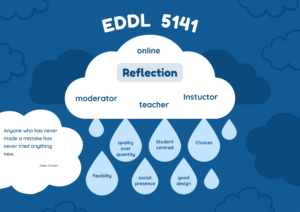
Week 9 -LA#1
Enhancing Community in Online Nursing Education
Creating a sense of community in online nursing education is essential yet challenging. Drawing from the readings below, three strategies resonate for me to foster connections and engagement among students and instructors.
Effective Strategies:
- Instructor Modeling: Instructors play a crucial role by actively participating in discussions, providing prompt feedback, and demonstrating professional values, setting a tone for empathy and collaboration.
- Interactive Dialogue: Structured discussions and group activities encourage peer support and collaborative learning, critical in nursing education for developing critical thinking and practical skills.
- Purposeful Course Design: Incorporating interactive elements like forums, virtual simulations, and live sessions in course design can significantly enhance engagement and provide varied learning opportunities.
Addressing Challenges:
- Presence and Engagement: Overcoming the absence of physical cues and varying digital literacy levels among students requires innovative use of multimedia and clear guidelines for participation.
- Practical Skills Development: Leveraging virtual simulations and arranging for in-person experiences, where feasible, can help bridge the gap in teaching practical nursing skills online.
Overcoming Obstacles:
Adopting a mix of synchronous and asynchronous methods, offering virtual office hours, and creating informal virtual spaces can mitigate feelings of isolation and strengthen the learning community.
Conclusion:
By integrating these strategies and acknowledging the challenges of online learning, nursing educators can build a supportive and effective educational environment that prepares students for the demands of the nursing profession.
- Dunlap, J.C., & Lowenthal, P.R. (in press). The power of presence: Our quest for the right mix of social presence in online courses. In A.P. Mizell & A. A. Piña (Eds.) Real life distance education: Case studies in practice . Charlotte, NC: Information Age Publishing. Retrieved from http://patricklowenthal.com/publications/The_power_of_presence–our_quest_for_the_right_mix_of_social_presence_in_online_courses.pdf
- Vesely, P., Bloom, L., & Sherlock, J. (2007). Key elements of building online community: Comparing faculty and student perceptions. MERLOT Journal of Online Learning and Teaching ,3 (3), 234-246. Retrieved from http://jolt.merlot.org/vol3no3/vesely.pdf CC BY-NC-SA 3.0 US
Week 7- LA #2
The Five Stage Model and the Community of Inquiry (COI) framework are influential concepts in online and blended learning, offering perspectives on how to foster effective learning environments. They share common goals in enhancing educational experiences but approach them through different lenses. Here’s a comparison highlighting their similarities and differences:
Five Stage Model
Gilly Salmon developed the Five Stage Model, a structured framework designed to facilitate online learning and e-moderation. She explains it by using the metaphor of climbing a mountain with the support of the sherpa who is there to guide, support and assist. It outlines five progressive stages that learners move through in an online course:
- Access and Motivation: Ensuring participants can access the online environment and are motivated to engage. The learner sees the mountain.
- Online Socialization: Encouraging participants to connect and form a learning community. The learner begins to form groups to support the ascent.
- Information Exchange: Involves sharing and disseminating information among participants. The learners share what they know about climbing the mountain and use the sherpa’s support to deepen their understanding.
- Knowledge Construction: Collaboratively building knowledge through dialogue and interaction. Through the interaction in their groups and the sherpa’s support and guidance, the learner has reached the summit.
- Development: Applying the knowledge gained in practical or reflective ways. Now that the learner is at the summit of the mountain they can use all they have learned getting to this place and start to apply it to other areas of learning, This allows the learner to integrate the learning.
Community of Inquiry (COI) Framework
The COI framework, developed by Garrison, Anderson, and Archer, focuses on creating a deep and meaningful learning experience through the development of three interrelated presences:
- Social Presence: The ability of participants to project their personal characteristics into the community, thereby presenting themselves as “real people.”
- Cognitive Presence: The extent to which learners are able to construct and confirm meaning through sustained reflection and discourse.
- Teaching Presence: The design, facilitation, and direction of cognitive and social processes to achieve personally meaningful and educationally worthwhile learning outcomes.
Similarities
- Both models emphasize the importance of building a learning community where participants feel connected and supported.
- Both suggest that learning occurs through a progression of stages or steps, whether it’s the development of community and cognitive abilities or the sequential stages of engagement in the learning process.
- Both frameworks value interaction and collaboration among learners and between learners and instructors as essential for effective learning.
Differences
- The Five Stage Model provides a more structural approach to the development of online learning, focusing on activities and strategies across different stages. The COI framework, on the other hand, centres on the qualitative aspects of the learning environment through social, cognitive, and teaching presences.
- The COI framework distributes the responsibility for facilitating learning more broadly across social, cognitive, and teaching presences without specifying a particular role like an e-moderator.
The Five Stage Model is a practical guide for structuring online courses, and the COI framework provides a theoretical foundation for understanding the dynamics of online learning environments. Despite their differences, the Five Stage Model and the COI framework contribute valuable insights into designing and facilitating effective online learning experiences. They complement each other, with the Five Stage Model offering a practical roadmap for course development and the COI framework providing a deeper understanding of the essential elements that constitute a rich learning environment. Integrating the strengths of both models could lead to more engaging, effective, and meaningful online learning experiences.
Vaughan, N. D., Cleveland-Innes, M., & Garrison, R.D
Salmon, G. (2006). 80:20 for e-moderators. In: The challenge of ecompetence in academic staff development . CELT, NUI Galway, Galway, Republic of Ireland, pp. 145-154. Retrieved from https://eprints.usq.edu.au/18862/2/Salmon_Ch16_2006_PV.pdf
Salmon, G. (2006). Climbing the Learning Mountain [Video file]. Source: https://youtu.be/GbwJMKWFfbI
. (2013). Facilitation. In Teaching in blended learning environments: Creating and sustaining communities of inquiry (pp.45-62). Athabasca, AB: Athabasca University Press. Retrieved from http://www.aupress.ca/books/120229/ebook/03_Vaughan_et_al_2013-Teaching_in_Blended_Learning_Environments.pdf CC BY-NC-ND 2.5 CA
Week Four- LA#3
The KwikReader course that I am working through has some elements of both the ADDIE and the Dee Fink models. It also utilizes the steps in Gagne’s nine events of instruction. The program used the first step in the ADDIE model- Analysis — This phase involves clarifying the instructional problem, establishing the instructional goals and objectives, and identifying the learning environment and the learner’s existing knowledge and skills (Bates, 2015). The program has done a great job of using analysis to target the learning population likely to be interested in this course; they have employed the concept to assess learners’ prior knowledge and characteristics (Bates, 205). This analytic foundation has provided an approach focusing on a very narrow learning outcome and then building on how to ensure the learner can meet that outcome. Due to this focused analytical framework, the design is also focused and follows the “D” in the ADDIE instructional design model by using the data gathered by the first phase to design a course that has specific course material unique to the course and that supports the learner to meet the learning outcomes successfully. This course also relies heavily on Gagne’s theory by grabbing the learners’ attention, summarizing course goals, linking previous knowledge to new skills/knowledge learned, and teaching the lessons in segments that allow the learners to practice and measure success as they go along (Arshaskiy, 2016).
I suspect this design model was chosen for its simplicity and because it is a proven method for designing content with clear learning objectives that align with structured content (Bates, 2015). The KwikReader program has many associated learning programs, and using the ADDIE method probably made it easier to develop other programs using a “cookie cutter” type approach to the design. The ADDIE model is a valuable tool to support the management and production of courses with the same quality or standards (Bates, 2015).
The KwikReader program is a bit “gimmicky” and might put some people off because of a definite “sales pitchy” vibe. Still, it follows good course design theory, and there are many current subscribers, so I think the designers have done their job well.
Arshavskiy, M. (2016). Leveraging Gagné’s nine events of instruction . Retrieved from https://elearningindustry.com/leveraging-gagnes-nine-events-of-instruction
Bates, A.W. (2015). The ADDIE model. In Teaching in a digital age: Guidelines for designing teaching and learning Vancouver BC: Tony Bates Associates Ltd. Retrieved from https://opentextbc.ca/teachinginadigitalage/chapter/6-5-the-addie-model/ CC BY-NC 4.0

